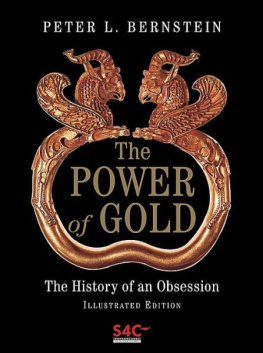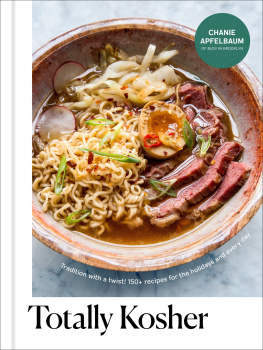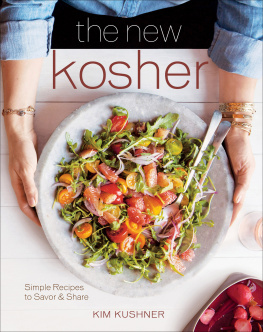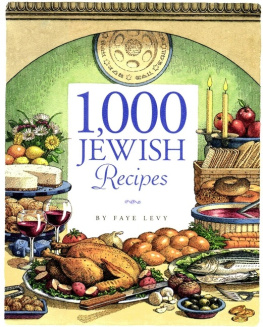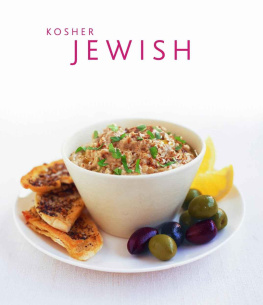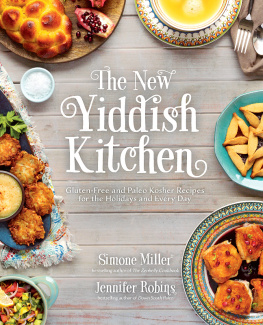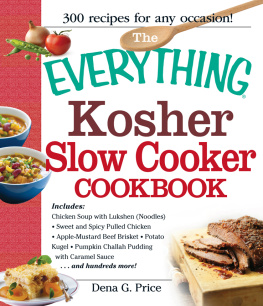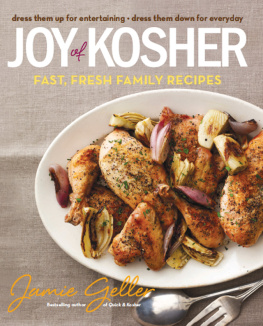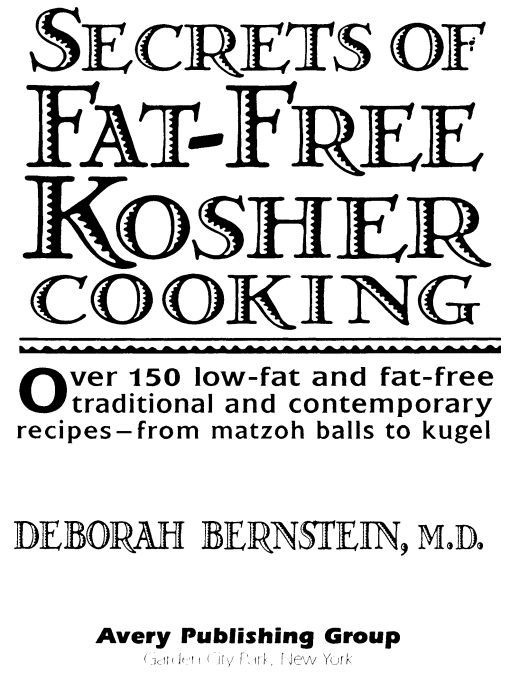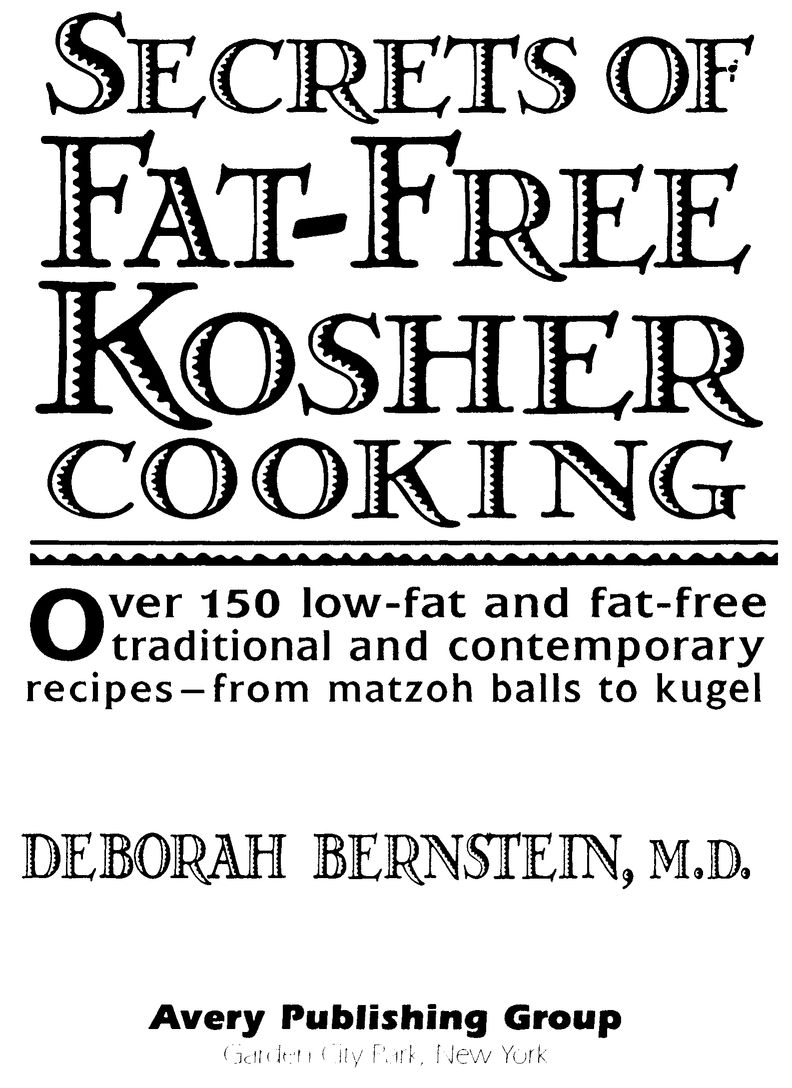Table of Contents
To David
and
To my mother and father.
Acknowledgments
I would like to thank the following people, who were important in the creation of this book:
Managing editor Rudy Shur, editor Marie Caratozzolo, and everyone at Avery Publishing Group, for giving me the opportunity to publish this book and for the chance to work with such nice people.
My husband, David Kleinman, M.D., for patiently enduring endless variations of the recipes that led to this book.
My parents, Leo and Paula Bernstein, for their loving support and encouragement.
Rabbi Mordechai Willig of the Young Israel of Riverdale, Rosh Yeshiva of the Rabbi Isaac Elchanan Theological Seminary of Yeshiva University, for his clarification of the laws regarding kosher cooking and cooking for the Sabbath.
My friend, Jack Nuszen, D.O., who showed me that cooking for ten on a moments notice can be fun.
And my best friend, Karen Cassouto Goliger, for listening to me kvetch.
Preface
COOKING 101
Learning to cook was a somewhat unusual experience for me. My wedding took place three days after my first year of medical school ended. I knew that for the next seven or eight years, I would be incredibly busy attending classes and serving my internship, residency, and fellowship. With these time constraints, I was afraid that I had to resign myself to meals that consisted of little more than canned tuna. I also knew that if I didnt learn to cook easy meals, inviting guests for dinner would probably occur only about once a year! This reality prompted me to learn to cook healthy kosher meals that were very, very quick and very, very easy.
Growing up, I learned a lot about cooking from my mother, who was my most invaluable resource for this cookbook. However, I also knew that I wouldnt be able to spend as much time preparing foods as she does. So I searched through cookbooks and other sources for recipes with kosher ingredients that were quick and easy to prepare, as well as healthful. I found exactly none. Most cookbooks had recipes with about sixteen steps or more, along with a long list of hard-to-find ingredients. How was I going to find fresh chives, when I barely had the time to buy fresh milk? (Fat-free ice cream in your coffee does work, by the way.) Even recipes from a number of supposedly easy cookbooks often had instructions that read, Begin to prepare this in the early afternoon. Obviously, these werent going to work for my lifestyle.
I began to experiment with various recipes that I found in cookbooks and magazines. I modified ingredients to make each non-Kosher recipe kosher, and I tried eliminating needless steps to save time. It wasnt easy. I did find that many recipes had steps that were absolutely needless. For instance, I discovered that most ingredients do not have to be pureed in small batches or strained three times through cheesecloth, and those recipes that require such steps are simply not for people with busy lives. Many times, however, my efforts had to be scrapped, and I found myself starting over again.
Shopping was another problem for me because of time constraints. I never knew when I would have time to shop, so I relied almost exclusively on nonperishable or frozen items. bought a large spice rack and stocked it well with dried herbs and spices to always have on hand. I bought items like peanut butter, soy sauce, jellies and jams, pasta, and dried and canned beans. I bought a second freezer so I could stock up on frozen foods. It was important for me to be able to prepare quick-and-easy, yet healthful kosher meals, at least when I could stay awake long enough to eat them.
KOSHER AND OTHER ETHNIC DISHES
Kosher cooking has always had a reputation for being high in fat and calories; but, with a little creative work (elbow grease instead of schmaltz), most classic kosher dishes can be made fat-free or very-low fat without compromising the taste and texture of the originals. My fat-free hamantaschen, for example, gain their characteristic texture from fruit pure and egg whites, as do my fat-free kugels. And my Grandmothers split pea soup is made rich with the flavor of turkey pastrami instead of beef flanken.
I live in an urban multicultural neighborhood. To meet the needs of the residents, the local grocery stores carry a wide range of ethnic products, many of which have undergone kosher supervision. This has given me the wonderful opportunity to try new and different dishes and experiment with ingredients from the cuisines of many countries. French, Italian, Spanish, Chinese, Indian, and Mexican-style recipes, as well as dishes with a Caribbean island and American southwestern influence are presented in this book. All of these ethnic creations, which follow the laws of kosher cooking, are simple to prepare, fat-free or very low in fat, and absolutely delicious.
QUICK AND EASY COOKING
Quick and easy are two words that characterize my recipes, which have short preparation timesmost can be prepared in under ten minutes, a few take less than two. They also require short cooking times and, best of all, an absolute minimum of fuss. Most recipes adhere to the following guideline: stir the ingredients together, cook them, and when the timer goes off, serve and enjoy.
Even during the most hectic years of my life, I found that I enjoyed cooking. For me it is a wonderfully creative outlet. My favorite challenge is to experiment with an ingredient to create a new dish, or bring an unusual twist to an old standby. My hope is that this cookbook will start you on your way to creating your own healthful and easy kosher dishes.
Introduction
While there are a number of kosher cookbooks on the market today, this is the first one that is geared exclusively toward delicious kosher dishes that are fat-free or very low in fat. During the early stages of this book, whenever I discussed its premise with my friends and colleagues, their reactions were always the same: Tasty low-fat kosher? Impossible! While I had to admit that kosher food does have the reputation for being high in fat, my health-conscious side as a physician made me determined to prove the skep-tics wrong. I believed that with a few ingredient adjustments coupled with some sound cooking methods, I could create delicious low- and no-fat foods that are as high in nutrition as they are in flavor.
The result of my efforts proved fruitful. This book is bursting with delicious low-fat and fat-free traditional and contemporary kosher dishes, such as chicken soup with matzoh balls, gefilte fish, and a variety of kugels and chulents. There are also appetizers, entres, side dishes, and desserts.
Yes, this book provides nutritious taste-tempting dishes that are amazingly quick and simple to prepare. But above all else, the recipes conform to the laws of kashrus (kosher foods), whose rich tradition is firmly rooted in the Bible. The following material highlights and summarizes the basic principles underlying this time-honored religious practice.
KOSHER CERTIFICATION
For a dish to be considered kosher, all of its ingredients must be certified through rabbinic supervision. There are several organizations in the United States and in countries throughout the world that perform this certification. Kosher foods and food products are easily identifiable by a symbol, which appears on their labels. This symbol usually represents the organization that has certified the product. For example, the letter U within a circle is the symbol of the Orthodox Union. Any label bearing this symbol signifies that the product has been certified kosher by the Orthodox Unionthe largest kosher certification organization in the United States. There are a number of national and regional organizations that perform this service, some of whose symbols are presented below.




